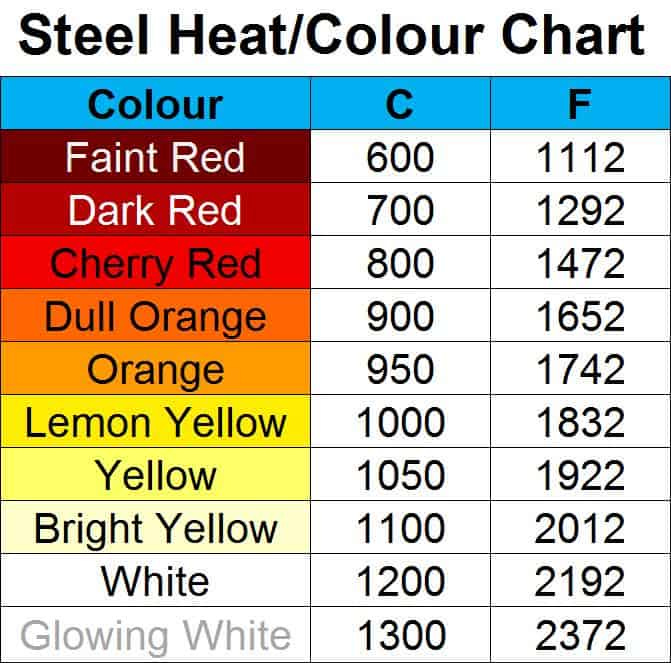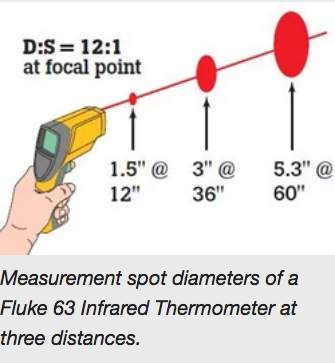How Infrared Temperature Guns Work
These measurement tools are great, but only if you know how to use them...
It’s getting hot in here… but just how hot?
First of all, here’s what an infrared temp gun looks like. Most of them have a handgrip like a pistol (hence the name “gun”), with a readout screen on the back and a laser pointer on the front. But it’s not quite as simple as “point ‘n shoot.” You first have to understand how infrared temp guns work in general, then you need to know the distance to spot diameter ratio of your particular make and model infrared temp gun. There’s fun learning ahead, so don’t be scared.
Infrared heat guns don’t read the temperature of the air at all like a regular thermometer would. No, what they’re looking at is something called black body radiation. Basically, as any object is heated above absolute zero (–273.15°C or –459.67°F) it begins to vibrate at a molecular level. And that vibration can be seen as a color.
All those colors…
You may have noticed that as you put a metal poker in a fire it will glow red from the heat. As it gets even hotter the color will change to orange and then yellow. Blacksmiths use this visual color scale all the time to figure out just how hot a piece of metal is in a forge prior to beating it into shape.
But this color scale also occurs in the infrared region. And infrared is simply a color that’s so low in frequency that we can’t see it with our own eyes. But we can easily build an electronic eye that can see that deep (infra) red color and correlate it to a temperature above absolute zero. For best accuracy the object should be dull in color to begin with (black body, get it?), so that hints at the first limitation of an infrared temp gun. They won’t do well finding the temperature of anything shiny like a mirror or even the polished aluminum of your Airstream trailer. But for everything else that’s a little dirty or dull in color they can be pretty accurate.
It’s all about the distance…
Next, that little laser beam that’s pointing at the object you’re measuring isn’t really a pinpoint measurement that the laser dot would suggest. Nope, the infrared temp gauge is really like a flashlight beam in reverse. That is, the farther you are away from the object you’re measuring, the bigger the area that it’s going to measure. And if there’s one hot-spot in the middle of a bunch of warm areas, the hot-spot temp won’t be measured at full temp. The meter will indicate the “average” temperature of the measurement spot diameter, and that’s dependent on the D:S ratio (distance to spot ratio), as well as how far you’re away from the object to be measured.
So an infrared meter with a 12:1 D:S ratio will “see” and measure the average temperature in a circle of about 1″ diameter when you’re 1 foot away. Measure something that’s 2 feet away and it’s “seeing” a 2″ diameter circle. And 3 feet away from the object you’re measuring will find the average temperature of a spot diameter around 3″. A temp gun with an 8:1 D:S ratio will read a 1″ diameter spot at 8″ away. And one with a 16:1 Ratio will read a 1″ diameter spot at 16″ away. So the higher the D:S ratio number, the further you can be away from an object that you’re trying to measure. Get it?
Math alert…
If you try to measure the temperature of a 1″-diameter bolt from 24″ away using an infrared temp gun with a 12:1 D:S ratio, it will average the temp of the bolt that has 0.78 square inch of area (remember, area of a circle is Pi times the radius squared), with the entire 2″-diameter circle having an area of 3.14 square inches. Since the area of your hot bolt is only about 1/4 of the entire spot that’s being measured, its temperature will only contribute about 1/4 of the average reading. So if the bolt was actually 200 degrees F, and the surrounding object was 100 degrees F, then the temp gauge might read only 125 degrees. And that could give you a false sense of confidence.
So what to do? Well, first of all know the D:S ratio of your particular infrared temp gun, and try to keep it within that distance from the object you’re measuring, depending on its size. So a 1″ object should be measured from a distance within 8″, 12″ or 16″ depending on your infrared temp gun’s D:S rating.
Of course if you’re standing near a hot spring at Yellowstone Park and you’re 10 feet away, then the 10″ diameter measurement spot is going to be all the same temp, and you’ll get an accurate reading that will wow the crowd. So have fun with it, but at an appropriate (and safe) distance.
You can get a Southwire 31212S 930◦F Infrared Thermometer with Dual Laser Targeting for less than $40 on Amazon.
Want to learn even more about how infrared temperature guns work? Then read THIS ARTICLE from Fluke, which is written in very understandable language. See, I told you not to be afraid.
Let’s play safe out there… Mike











"Cool" article! Great explanation, Mike!
Battery Charging problem in new Airstream Rangeline. Fix OK? https://www.youtube.com/watch?v=mmpBsELaT60